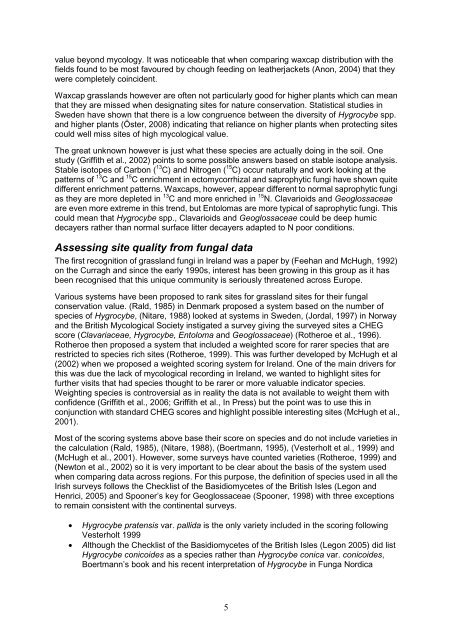North Kerry Waxcap Survey 2012 - the Northern Ireland Fungus Group
North Kerry Waxcap Survey 2012 - the Northern Ireland Fungus Group
North Kerry Waxcap Survey 2012 - the Northern Ireland Fungus Group
You also want an ePaper? Increase the reach of your titles
YUMPU automatically turns print PDFs into web optimized ePapers that Google loves.
value beyond mycology. It was noticeable that when comparing waxcap distribution with <strong>the</strong><br />
fields found to be most favoured by chough feeding on lea<strong>the</strong>rjackets (Anon, 2004) that <strong>the</strong>y<br />
were completely coincident.<br />
<strong>Waxcap</strong> grasslands however are often not particularly good for higher plants which can mean<br />
that <strong>the</strong>y are missed when designating sites for nature conservation. Statistical studies in<br />
Sweden have shown that <strong>the</strong>re is a low congruence between <strong>the</strong> diversity of Hygrocybe spp.<br />
and higher plants (Öster, 2008) indicating that reliance on higher plants when protecting sites<br />
could well miss sites of high mycological value.<br />
The great unknown however is just what <strong>the</strong>se species are actually doing in <strong>the</strong> soil. One<br />
study (Griffith et al., 2002) points to some possible answers based on stable isotope analysis.<br />
Stable isotopes of Carbon ( 13 C) and Nitrogen ( 15 C) occur naturally and work looking at <strong>the</strong><br />
patterns of 13 C and 15 C enrichment in ectomycorrhizal and saprophytic fungi have shown quite<br />
different enrichment patterns. <strong>Waxcap</strong>s, however, appear different to normal saprophytic fungi<br />
as <strong>the</strong>y are more depleted in 13 C and more enriched in 15 N. Clavarioids and Geoglossaceae<br />
are even more extreme in this trend, but Entolomas are more typical of saprophytic fungi. This<br />
could mean that Hygrocybe spp., Clavarioids and Geoglossaceae could be deep humic<br />
decayers ra<strong>the</strong>r than normal surface litter decayers adapted to N poor conditions.<br />
Assessing site quality from fungal data<br />
The first recognition of grassland fungi in <strong>Ireland</strong> was a paper by (Feehan and McHugh, 1992)<br />
on <strong>the</strong> Curragh and since <strong>the</strong> early 1990s, interest has been growing in this group as it has<br />
been recognised that this unique community is seriously threatened across Europe.<br />
Various systems have been proposed to rank sites for grassland sites for <strong>the</strong>ir fungal<br />
conservation value. (Rald, 1985) in Denmark proposed a system based on <strong>the</strong> number of<br />
species of Hygrocybe, (Nitare, 1988) looked at systems in Sweden, (Jordal, 1997) in Norway<br />
and <strong>the</strong> British Mycological Society instigated a survey giving <strong>the</strong> surveyed sites a CHEG<br />
score (Clavariaceae, Hygrocybe, Entoloma and Geoglossaceae) (Ro<strong>the</strong>roe et al., 1996).<br />
Ro<strong>the</strong>roe <strong>the</strong>n proposed a system that included a weighted score for rarer species that are<br />
restricted to species rich sites (Ro<strong>the</strong>roe, 1999). This was fur<strong>the</strong>r developed by McHugh et al<br />
(2002) when we proposed a weighted scoring system for <strong>Ireland</strong>. One of <strong>the</strong> main drivers for<br />
this was due <strong>the</strong> lack of mycological recording in <strong>Ireland</strong>, we wanted to highlight sites for<br />
fur<strong>the</strong>r visits that had species thought to be rarer or more valuable indicator species.<br />
Weighting species is controversial as in reality <strong>the</strong> data is not available to weight <strong>the</strong>m with<br />
confidence (Griffith et al., 2006; Griffith et al., In Press) but <strong>the</strong> point was to use this in<br />
conjunction with standard CHEG scores and highlight possible interesting sites (McHugh et al.,<br />
2001).<br />
Most of <strong>the</strong> scoring systems above base <strong>the</strong>ir score on species and do not include varieties in<br />
<strong>the</strong> calculation (Rald, 1985), (Nitare, 1988), (Boertmann, 1995), (Vesterholt et al., 1999) and<br />
(McHugh et al., 2001). However, some surveys have counted varieties (Ro<strong>the</strong>roe, 1999) and<br />
(Newton et al., 2002) so it is very important to be clear about <strong>the</strong> basis of <strong>the</strong> system used<br />
when comparing data across regions. For this purpose, <strong>the</strong> definition of species used in all <strong>the</strong><br />
Irish surveys follows <strong>the</strong> Checklist of <strong>the</strong> Basidiomycetes of <strong>the</strong> British Isles (Legon and<br />
Henrici, 2005) and Spooner’s key for Geoglossaceae (Spooner, 1998) with three exceptions<br />
to remain consistent with <strong>the</strong> continental surveys.<br />
• Hygrocybe pratensis var. pallida is <strong>the</strong> only variety included in <strong>the</strong> scoring following<br />
Vesterholt 1999<br />
• Although <strong>the</strong> Checklist of <strong>the</strong> Basidiomycetes of <strong>the</strong> British Isles (Legon 2005) did list<br />
Hygrocybe conicoides as a species ra<strong>the</strong>r than Hygrocybe conica var. conicoides,<br />
Boertmann’s book and his recent interpretation of Hygrocybe in Funga Nordica<br />
5


